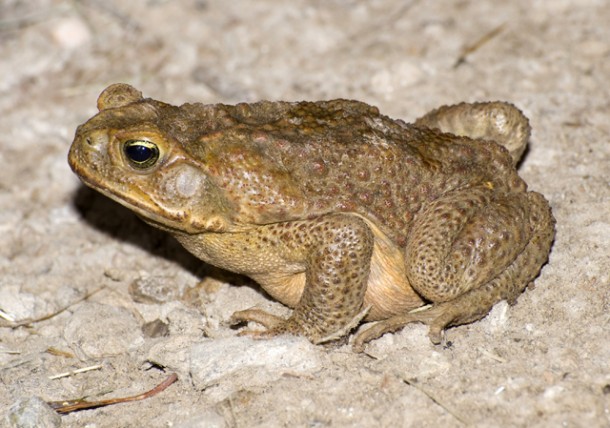Toad Toxicity

Along the Gulf Coast, a very prevalent resident of our backyards harbors one of the more common toxins to dogs. The bufo marinus (the Giant, Marine or Cane toad) commonly attracts a curious pet with their large size and jumping motion. While there are other similar, potentially toxic toads throughout Texas, the bufo marinus is more dangerous and most prevalent in the Rio Grande Valley. They are rather defenseless-looking creatures, but they are loaded with an extremely toxic chemical located in glands along their back. When a dog bites or mouths the toad, these chemicals are released from the glands and absorbed through the mucous membranes of the dog’s mouth into the bloodstream.
The toxin can then cause a multitude of effects, such as vomiting, diarrhea, trembling, panting, increased salivation, “brick-colored” red gums, very high and irregular heart rate, seizures and possible death due to heart failure. The severity is dependent on contact time, the amount of toxin absorbed and the dog’s size. Smaller breeds are potentially the most severely affected.
Avoiding toads is the best way to keep your pet safe, but that is easier said than done. The toads have been known to eat from a pet’s food bowl and can leave their toxin in a bowl of water. The toads are nocturnal and often attracted to outdoor lights where they can snatch a tasty bug. They are often found in grassy yards with places to hide like water sprinkler boxes. Keeping your pet under a watchful eye at night and removing toads from their normal residences may prevent encounters.
The recognition of exposure and rapid treatment are keys to saving the life of your pet. If you observe your dog mouthing a toad, you should immediately begin to rinse its mouth with a very wet washcloth. Washing the mouth helps to remove and dilute the toxin. This should be done for at least thirty seconds and done carefully to prevent water from getting into the trachea (windpipe). Lowering the head below the lungs may help keep water out. You should then immediately head to your veterinarian’s office or emergency clinic. Be careful not to get bitten if your pet is having seizures or appears to be hallucinating. Make sure to wear protective gloves and thoroughly wash your hands, as the toad’s toxin can harm your skin as well.
There is not an antidote to the toxin, so treatment consists of removing the toxin, fluids given via IV, seizure control, temperature regulation and sometimes medications to protect heart function.
With early treatment (especially washing out the mouth), most patients recover within 12 hours without experiencing long-term effects. Pets that are not treated promptly have a very high incidence of death. Prevention, early recognition and immediate treatment are the keys to keeping your pet safe.
David Heflin, DVM works at Mission Veterinary Hospital in Mission, Texas. Dr. Heflin lives in McAllen, Texas.


Thank you for the information sir. A friends dog was sprayed by some type of frog, toad etc. out on her ranch west of Raymondville. I believe the dog is ok, she took it to the vet and he charged a lot of money! I`m going to start hunting them. Can they spray me and what can i expect? The owner used the term Spray, that`s why i`m using the term!
My son had these as pets, I dont think they hurt humans. I believe they are mostly poisonous if eaten/brought near mouth. My son and neighbors handle them all the time and no problems for years.
My son had these as pets, I dont think they hurt humans. I believe they are mostly poisonous if eaten/brought near mouth. My son and neighbors handle them all the time and no problems for years.